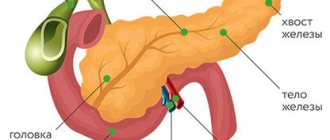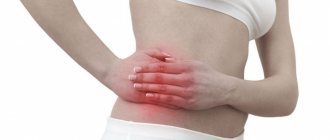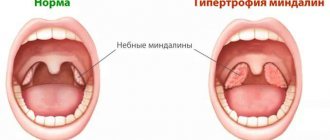Twisting of the intestine around the intestinal or mesenteric axis leads to intestinal obstruction. The disease is called volvulus. The intestinal walls are compressed, which leads to disturbances in the intestinal walls. Lack of supply of nutritional components and blood circulation leads to necrosis and peritonitis of the digestive tract.
The essence of pathology
In cases of volvulus, the intestinal loops twist around their axis or the mesenteric one. Transport of food is disrupted even when the baby's intestinal loop deviates 90 degrees from its normal direction. A larger angle causes compression of the arterial vessels and nerve branches passing between the layers of the mesentery. Volvulus can be observed in several areas or in one place.
As a result, a section of the intestine stops receiving nutrition, and the wall becomes necrotic. Following necrosis, vascular permeability increases, and effusion into the abdominal cavity begins. The intestinal wall ruptures and the contents exit into the abdominal cavity. This means that fecal peritonitis is developing. This creates a mortal danger for the baby. The only way to save the child is urgent surgery.
Why does it occur in infants?
The most common cause of intestinal volvulus, as observed by pediatric surgeons, is congenital developmental anomalies. They are more concerned with the small intestine. Determined in a newborn or under one year of age.
If the intrauterine formation of the fetus is disrupted, anatomical deviations are possible:
- excessively long mesentery (the most common cause of small intestinal volvulus);
- violation of the size of the initial and final sections of the intestine;
- internal hernia;
- formation of a cyst or tumor on the mesentery;
- functional insufficiency of the sphincter system and valves of the gastrointestinal tract;
- connection of intestinal loops by the common mesentery.
The development of anomalies is associated with:
- with a complicated pregnancy;
- forced treatment of the expectant mother with antibacterial drugs;
- malnutrition;
- hereditary disorders.
In infants, the first signs of obstruction may begin with the introduction of complementary foods or a sudden transition to artificial feeding
What matters is the unpreparedness of the underdeveloped digestive system to accept a new food substance. A reaction occurs in the form of impaired peristalsis: instead of alternating contractions of the circular and longitudinal fibers, pronounced spasms and a reverse wave are formed. Volvulus is caused by constipation in infants and stagnation of feces.
Clinical manifestations
Symptoms of the disease are associated with the resulting intoxication of the body. The mechanism of its appearance is determined by blocking the access of blood to the intestinal sections. During torsion, a significant part of the intestine is compressed, and the blood supply and innervation to this and nearby areas and the mesentery are cut off. Without blood flow, nutrients and oxygen do not enter the tissues, and necrosis develops. When the intestinal lining dies, its permeability increases, which serves as an entry point for toxins and infection, causing fecal peritonitis.
The onset of the disease is characterized by general symptoms of intestinal dysfunction, which develop into symptoms of obstruction:
- Dyspeptic disorders. The first manifestations are nausea and vomiting. Rare vomiting indicates damage to the thick part, profuse vomiting indicates damage to the thin part. Vomit has a strong pungent odor.
- Stopping gas emissions within a few days.
- Stool disorders in the form of constipation due to blockage of a section of the intestine.
- Bloating or hard belly syndrome.
- Pain in the abdominal area. Severe cramping pain appears in the abdomen, the patient takes a forced position in bed.
In infants, at the onset of the disease, severe pain is replaced by periods of relief; the child can fall asleep and eat. As it worsens, weakness and moodiness appear. During the period of intoxication, body temperature rises and vomiting occurs. Before the complete cessation of bowel movements, blood elements are detected in the stool.
Intoxication is life-threatening for children and adults. The condition is dangerous due to the development of dehydration of brain tissue, systems and organs.
Pathological conditions that contribute to bloat in a child
At the age of 6 years, a common cause is the formation of a helminthic ball in the intestines to the point of complete obstruction. Other reasons include:
- dehydration of the body due to lack of drinking, in the heat, in cases of severe intoxication;
- abdominal injury;
- functional or pathological spasm and intestinal paresis;
- adhesions after surgery or untreated enterocolitis;
- compression of intestinal loops by a tumor formation or cyst;
- Hirschsprung's disease is a rare congenital disease, determined by the absence of nerve endings in the wall of the large intestine, in these areas peristalsis is impossible, constipation occurs; but the overlying intestine actively contracts, this creates conditions for volvulus of the sigmoid colon in newborns;
- megacolon is a congenital anomaly, expressed in a significant enlargement of the large intestine and underdevelopment of the system of nerve endings, manifested by persistent constipation from the first month of life.
General information
Intestinal volvulus is the twisting of a loop of any intestine around the axis of the mesentery and its pinching. This condition is classified as strangulating intestinal obstruction . Torsion of the mesentery itself may involve the mesenteric vessels, increasing the risk of intestinal gangrene with subsequent perforation and peritonitis .
If we take into account age, this pathology most often occurs in adulthood and old age. This pathology cannot be excluded in children, especially newborns, which is associated with congenital intestinal pathology and imperfections of the gastrointestinal tract. If we consider localization, then in adults the most common volvulus of the large intestine is the sigmoid colon (in 80% of cases, which is due to the structural features of the mesentery - it has a significant length), the cecum (15% of cases) and the transverse colon (only 3% ), and in children - the small intestine. Inversions can be partial or complete. With complete inversion, the intestinal loop and mesentery are twisted by 2500-3600. In rare but severe cases, there may be double or triple torsion and the formation of knots. This condition is acute and requires urgent intervention.
Symptoms of volvulus in children
Clinically, volvulus is manifested by mechanical obstruction at the site of torsion. Attentive parents can notice the initial symptoms. The pain syndrome occurs suddenly, the child screams. Older children describe the cramping nature of the pain. Pain shock may develop.
Repeated painful vomiting with an unpleasant odor. In case of small intestinal obstruction, first the food eaten, then the intestinal stool. Vomiting does not bring relief; it is more pronounced with volvulus of the small intestine. A rare gag reflex indicates a lesion in the large intestine.
Asymmetrical bloating of the abdomen due to overinflation of the adductor colon and collapse of the efferent colon, tension in the muscles of the abdominal wall. In the initial period, the passage of feces, then complete retention of stool and gases. When giving an enema, if a volvulus occurs in the small intestine, feces are released from the lower sections, and blood may be included.
A strangulated umbilical hernia creates conditions for intestinal torsion
Temperature rises to high levels with an abrupt decline. Babies often hiccup for three days, even after surgery. In a newborn baby, during volvulus, attention is paid to the cyanosis of the nasolabial triangle and the tendency to pull the knees towards the body. In the subacute course, attacks are accompanied by breaks and improvement. At the height of the illness, the baby becomes weak, lethargic, and restless. These are signs of increasing intoxication.
Symptoms and clinical picture
The first symptoms of volvulus are always associated with a violation of the digestive system .
In the early stages of the development of the disease, only an experienced specialist can diagnose the pathology.
The intensity of symptoms depends on the degree of intestinal twisting and the individual characteristics of the child’s body. Some signs may indicate pathology in advance .
For example, the pungent smell of vomit indicates the accumulation of feces in the intestines and a violation of its patency.
Symptoms of volvulus may include the following conditions:
- sudden increase in body temperature;
- pain in the abdominal area;
- acrid smell of vomit;
- attacks of nausea and vomiting;
- no gas formation;
- constipation;
- blood impurities in stool;
- decreased blood pressure;
- abdominal consolidation;
- deterioration of the general condition of the body.
Recommendations for the treatment of intestinal dolichosigma in a child can be found on our website.
Dangerous complications
The goal of starting therapy within the first 3 days from the onset of volvulus symptoms is to avoid complications. When they occur, the child’s condition sharply worsens and the prognosis for a successful outcome decreases.
Dehydration
Frequent, painful vomiting contributes to the loss of a significant amount of fluid and electrolytes. There is no absorption of the liquid part of feces in the colon during volvulus, which further aggravates the state of dehydration:
- blood thickens;
- blood pressure decreases;
- the strength of heart contractions decreases.
First of all, the brain suffers (dizziness, drowsiness, loss of consciousness). If 15% of fluid is lost, the patient dies.
Intoxication
Due to the increased permeability of necrotic areas of the intestine, non-neutralized waste and toxic substances enter the bloodstream through it. The body reacts with an increase in temperature, chills, muscle pain and headaches.
Wall perforation
Perforation (perforation) of the intestinal wall occurs as a result of its thinning due to poor nutrition. Therefore, a wave of peristalsis causes rupture of the intestine that has lost its strength. The contents of the loop (waste, poisons, feces, intestinal bacteria) enter the abdominal cavity. This is how fecal peritonitis is formed. The leaves of the peritoneum have a high absorption capacity. Through them, all toxic substances will additionally enter the bloodstream and further increase intoxication.
Gangrene of the wall
Necrosis of an area of the intestine with cessation of blood supply is called gangrene. Dead tissue enters the abdominal cavity during peritonitis. Therefore, for treatment it is so important to remove (excise) non-viable tissue in a timely manner. Then rinse the abdominal cavity repeatedly with antimicrobial agents.
Sepsis
Sepsis is a pathological condition caused by pathogenic microbes entering the bloodstream. They spread throughout the body, forming ulcers in any organ. Manifests itself as severe intoxication and resistance to antibiotics.
Adhesive disease
Adhesions are the growth of scar tissue at the site of former inflammation. They begin with the loss of fibrin film. The adjacent loops then become glued together, and the scar tissue displaces and changes the normal position of the loops. When it grows, the loop may be compressed. This promotes volvulus and poses a threat to life, since the adhesions will not disappear on their own.
Removed area with internal volvulus of the small intestine and gangrene
Procedures and operations
When a volvulus occurs in the small intestine, surgery is performed to straighten the volvulus. In the absence of peritonitis, the affected intestinal loops are excised and an anastomosis between the two ends of the intestine.
The main treatment method for cecal volvulus is also surgery. The intestine is straightened. In case of necrosis, hemicolectomy is performed with anastomosis. Shortening of the mesentery of the cecum is rarely performed recently, since recurrence of volvulus after this occurs with the same frequency as without shortening the mesentery. Weakened patients are offered percutaneous typhlostomy (a fistula in the cecum), but persistent fecal fistulas often occur after this procedure.
Sigmoid volvulus can be corrected by decompressing the loop using sigmoidoscopy . During this procedure, a tube is inserted into the intestine to prevent relapse. It is left in the intestine for 2-3 days, and a week later the operation is performed. Palliative intervention is performed if there are no changes in the intestinal wall. It includes straightening the volvulus and prophylactic shortening of the mesentery by gathering it into an assembly or fixing the sigmoid colon to the abdominal wall. Palliative interventions have a high rate of volvulus recurrence.
In case of necrosis of the intestine, a radical operation is indicated - its resection according to the general rules with an "end to end" or "end to side" anastomosis. If there is a complication in the form of intestinal gangrene, a resection of the non-viable area is performed, but an anastomosis between the ends of the intestine is not applied, but an unnatural anal opening (colostomy) is placed on the skin of the abdominal wall.
Removal of a sigmostoma is the safest option for surgery. During the second stage of the operation (after 3 months), the intestinal fistula is closed. Since it is very difficult to determine the viability of an intestinal loop in children, this tends to favor more active surgical tactics for volvulus of any part of the intestine.
Diagnostics
It is difficult to hold a small child in front of the X-ray screen or give him barium to drink. The basis of diagnosis is the experience of surgeons. When palpating the abdomen, the specialist palpates the swollen soft formation of the afferent loop, an empty space in the area of the efferent intestine.
Pay attention to the asymmetrical bloating of the child’s abdomen. A digital examination reveals an empty rectum. The absence of peristalsis is judged by auscultation of the abdomen and splashing noise. It is very difficult to distinguish intestinal volvulus from appendicitis in a small child. Almost final confidence in the diagnosis comes during surgery and visual examination of the intestine.
Tests suggest inflammation: leukocytosis and ESR are increasing. In the severe stage, the hematocrit drops due to dehydration, and electrolytes decrease.
Treatment
If similar symptoms appear, you must call an ambulance. Children, together with one of their parents, are hospitalized in the surgical department and are first observed. They are trying to relieve the volvulus and pain with novocaine blockade. The meaning of conservative measures is to relieve increased tension in the adductor loop and spontaneous deployment of the node.
Saline solutions, anti-shock drugs, painkillers, and Hemodez are administered through the subclavian vein to combat intoxication. Be sure to wash the intestines with a siphon enema. The condition improves with gastric lavage and installation of a thin gas outlet tube. Antibacterial drugs are administered intravenously or intramuscularly, depending on the child’s condition.
Symptoms and treatment of intestinal diverticulosis
Surgical treatment consists of straightening the loops and securing the mesentery if the intestinal tissue is viable. If necrotic areas are present, they must be removed (bowel resection).
The undamaged ends are connected using one of the methods. The adhesions are dissected. In specialized clinics, surgery is performed using laparoscopic technology.
In severe cases of peritonitis and inflammation of the intestinal loops, the ends cannot be sutured until the inflammatory reaction has resolved. Then you have to operate step by step:
- First, the necrotic area is removed and the stoma is placed on the skin of the abdomen (feces will flow into the colostomy bag);
- after the peritonitis is cured, about 3 months later, the second stage is carried out - the ends of the intestine are connected and the stoma is removed.
For newborns, a permanent catheter is installed in the umbilical vein for long-term fluid transfusion.
List of sources
- Doroshevsky Yu.V. Surgical treatment of newborns with rotation defects and rotation of the midgut. — Bulletin of Surgery. - 1978. - No. 2. - P. 92–97.
- Volvulus of the sigmoid colon. Errors in the diagnosis and treatment of acute diseases and injuries of the abdomen / Medicines and medicine: a medical reference book.
- Ioskevich, N. N. Practical guide to clinical surgery: Diseases of the digestive tract, abdominal wall and peritoneum / N. N. Ioskevich; edited by P. V. Garelika. Minsk: Vysh. school, 2001. 685 p.
- Smirnov A.N. with co-authors. Incomplete intestinal rotation in older children (clinic, diagnosis, treatment). — V. book: 4th Russian Congress “Modern technologies in pediatrics and pediatric surgery” (congress materials). - M., 2005. - P. 372.
- Totikov V.Z., Medoev V.V. Some issues of surgical treatment of sigmoid colon volvulus. // Vladikavkaz Medical and Biological Bulletin. Vladikavkaz. 2007. Volume 7. Issue 13. p. 320-323.
Nutritional Features
After successful conservative straightening of the volvulus, the risk of recurrence remains. Parents are informed about the prognosis and are recommended to organize dietary meals for the baby. Feeding must be done 6 times a day. All dishes should be pureed and easy to digest.
Liquid porridges made from oatmeal, rice, buckwheat, jelly, and slimy soups are suitable. You can add milk to them, but not fat. It is best for infants to continue breastfeeding. Dishes made from raw vegetables, juices, and flour products should not be allowed.
Diet
Diet 0 table
- Efficacy: therapeutic effect after 21 days
- Terms: 3-5 months
- Cost of products: 1200-1300 rubles. in Week
Diet Table No. 1
- Efficacy: therapeutic effect after 3 weeks
- Terms: 2 months or more
- Cost of products: 1500 - 1600 rubles. in Week
Diet Table No. 4
- Efficacy: therapeutic effect after 7-10 days
- Time frame: 21 days
- Cost of products: 1120-1150 rubles. in Week
Diet for partial intestinal obstruction should not contain large meals and overeating - this provokes an exacerbation. Avoid foods that increase gas formation (cabbage, soy products, legumes, whole milk, yeast baked goods). Patients are recommended to eat frequent, small meals. Sooner or later, the patient has to resort to surgical treatment, after which special nutrition is organized.
After the operation, food intake is possible after a few days, and for the first time tube feeding with special nutritional mixtures is organized. After a while, the patient switches to a zero diet - this is a diet designed for patients who have undergone operations on the digestive organs.
This is the most gentle nutrition in the form of sequentially assigned Tables - No. 0A , No. 0B , No. 0B . The basis of these tables is liquid, jelly-like and pureed food, which is consumed in small portions (no more than 200 g per meal) and often. Diets include easily digestible proteins, fats and carbohydrates, the amount of which gradually increases. All are characterized by a decrease in the amount of salt and an increase in fluid intake.
For the first 2-3 days of normal nutrition, the patient can eat mild and low-fat meat broth, liquid jelly, rice water with cream, compote without fruit, rosehip infusion, tea with sugar, fruit jelly, diluted freshly prepared juices. On the third day, add a soft-boiled egg and 50 ml of cream. Over the next 2-4 days, pureed porridge (rice, buckwheat, oatmeal) is introduced. They are boiled in water or broth. The serving volume increases to 350 g. By the end of the first week, puree soups, pureed boiled meat or fish, pureed cottage cheese diluted with cream to the consistency of sour cream, fermented milk drinks, fruit and vegetable purees, baked apples, and, if well tolerated, pureed milk porridges are introduced.
Thus, zero diets gradually load and train the gastrointestinal tract, serving as a transition to nutrition within Table No. 1 . They exclude whole milk (it is present only in dishes), all dishes with a dense consistency and carbonated drinks. Over time, food expands within Table No. 4 .
Why do relapses occur?
The operation was successful, the volvulus was straightened. But the patient or the baby’s parents are warned about the danger of relapse (repetition). Surgeons believe that the following play a role in the occurrence of relapses:
- Reduced scope of surgical intervention due to the severity of the patient’s condition (the loop was “untwisted”, but a long mesentery and a mobile cecum remained). Relapse can be avoided by suturing the wrapped loop to the abdominal wall.
- The formation of adhesions between the intestines, gluing together different parts of the intestine and predisposing to a new volvulus.
To prevent relapse, it is recommended:
- control the diet, avoid long breaks and overfeeding;
- prevent constipation, do not use laxatives;
- remember the importance of physical activity for a child, do joint exercises, and take more walks.
Causes
The following reasons can provoke intestinal blockage:
- prolonged constipation;
- foreign body ingress (swelling may form);
- pinching, abdominal injuries;
- regular overeating;
- hiatal hernia;
- infections, polyps;
- long mesentery;
- helminthiasis, blocking the internal space of the intestine;
- development of adhesions, tumor formations;
- paresis or intestinal spasms.
Torsion of loops in newborns occurs due to pathologies of intrauterine development. The organ defect is manifested by torsion. In infants, torsion occurs due to overfeeding with breast milk. Transferring a child under one year of age to formula milk can also provoke bloat. Early introduction of complementary foods also results in intestinal torsion.
Volvulus can lead to inflammatory processes in the abdominal cavity. Infants are more susceptible to the disease than older children. The consumption of fermented milk products and solid foods is limited. Children over three years of age are susceptible to bloat due to poor diet.
What to do when the baby grows?
As children grow older, anatomical anomalies become less dangerous or are completely eliminated. The consistency of the intestinal sphincters is improved. The size of the intestines becomes proportional. The body adapts quite well to life with its own characteristics.
But a threat can arise when chronic diseases appear during adolescence. Therefore, when raising a child, you need to pay attention to proper nutrition, avoiding any alcohol, soda, or fast food. The disease spares neither children nor the elderly. Seeking medical help gives you a chance not only to stay healthy, but also to survive.








